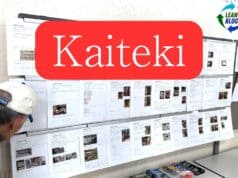2024 Preface: I'm re-posting this blog post from 2012 about Lean at Boeing. The WSJ headline emphasizes “speed up,” but that could be the fault of their editors not realizing that Lean means quality and flow go hand in hand.
The article shares an example where an employee-driven Kaizen improvement (a small, inexpensive improvement) would reduce quality problems (which then reduces delays and improves flow).
That's different than the accusations against Boeing in recent years that “schedule is king” is the mindset. In that case, rushing through work and emphasizing speed and production numbers would certainly hurt quality.
Here's the original post from 2012:
There was a nice article in the Wall Street Journal this week about the Boeing 737 and some of their Lean and Kaizen (continuous improvement) work:
“Boeing Teams Speed Up 737 Output — Jet Maker's Innovation Crews Search for Ways to Streamline Production as Aircraft Demand Soars.”
Boeing needs to increase production by more than 70%, so the company is looking to “rally employees for ways to make its jets more efficiently and avoid expanding its factories and its costs.”
One example of an employee-driven idea that helps prevent tires from being punctured on the line was explained:
Workers try to leave few stones unturned. Mr. Dohrmann, for example, came up with the canvas wheel covers that now hug the four main landing-gear tires as the single-aisle planes advance down an assembly line. The covers solved a vexing problem: stray metal fasteners on the factory floor sometimes puncture tires. The solution saves Boeing about $10,000 for each tire that needs to be replaced “roughly $250,000 a year at the Renton plant based on historical mishap” as well as the labor costs involved in replacing them.
The article highlights the connection of Kaizen to Lean. It's a nice (and rare) example of the WSJ recognizing that Lean isn't just about “just in time” and low inventory (see their record of mistakes).
Boeing started emphasizing employee-generated ideas in Renton in the late 1990s, when the 737 plant began adopting “lean” manufacturing techniques that were developed by the Japanese auto industry and embraced by U.S. car makers in the 1980s. Many companies, including fast-food giants, now use lean methods.
I wish they had included “including hospitals” instead of “fast-food giants.” Starbucks is using Lean, but what other “fast-food giants?”
2024 Update: I'm pretty certain that formal “Lean” is no longer used at Starbucks.
Many Seattle hospitals, including Virginia Mason Medical Center, have learned a lot about Lean from Boeing. Boeing is using the term “innovation teams” to describe the groups, some 1300 of them across their programs:
Boeing's employee teams are composed of workers with varying backgrounds-from mechanics to engineers-and tend to focus on a specific part of a jet, such as the galleys. Teams meet as often as once a week and typically have seven to 10 members.
That sounds a bit like the classic Japanese “quality circle” approach – something I haven't heard about in a long time. You hear more often about week-long events (ie. “rapid improvement events” or “kaizen events,” the latter term being a bit of a misnomer) or you hear about smaller “quick and easy kaizen” approaches popularized in the U.S. by Norman Bodek (and a major part of our upcoming Healthcare Kaizen book).
The WSJ piece talks about some improvements taking years to come to fruition – showing that not all Kaizen opportunities are quick and easy. It takes a mix of improvements and approaches to engage employees in fixing small problems and large, complicated ones. We certainly have a similar mix of problems and opportunities in healthcare. I hope we get more engagement of healthcare professionals in solving these important problems.
Updated: After I posted this, I got a great question via Twitter:
Yes, it would be ideal to find the root cause(s) of why there is metal on the floor to begin with. If this is a really sticky problem, then it might be reasonable (even if not ideal) to protect the tires from said metal.
Please scroll down (or click) to post a comment. Connect with me on LinkedIn.
Let’s work together to build a culture of continuous improvement and psychological safety. If you're a leader looking to create lasting change—not just projects—I help organizations:
- Engage people at all levels in sustainable improvement
- Shift from fear of mistakes to learning from them
- Apply Lean thinking in practical, people-centered ways
Interested in coaching or a keynote talk? Let’s start a conversation.








![When Was the Last Time a Leader Around You Admitted They Were Wrong? [Poll]](https://www.leanblog.org/wp-content/uploads/2025/07/Lean-Blog-Post-Cover-Image-2025-07-01T212509.843-100x75.jpg)

Hello Mr. Graban, I found this this article very interesting in seeing how everyday employees are able to contribute to companies and make them save tons of money for the companies and help ramp up production. You mentioned the fast food industry and the Kaizen being implemented in Starbucks only but, formal lean is not being used in Starbucks today. I was very curios of how you could even implement Kaizen into a fast food model. Most workers at fast food places are highschoolers and college students who have very little stakes in the company and are probably not to interested in improvements. Not to mention there are hundreds of thousand workers for some of these fast food giants and most of them are franchised out. How would you even go about implementing a process like Kaizen into this industry.
Hi Zachary – Thanks for reading the blog post and for your reflections and your question.
You raise some good points. People are more likely to participate in Kaizen when they have more at stake. That said, I think people have an innate and natural desire to make things better, even if it’s only for their own short term benefit of making work safer and easier.
In a company with zero turnover, one challenge might be employees getting so comfortable with the current state and its waste that they can no longer see the waste.
With some turnover, we get many new “fresh eyes” who might question “the way it’s always been done” and we can tap into that.
I think if the fast food franchise is a respectful work environment, people would gladly participate in Kaizen. They might even feel more satisfied and more valued — making them more likely to stay.